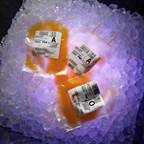R&D blog
With this series of blogs, we bring you an insight into the research that NHS Blood and Transplant are working on to improve patient and donor care.

Lab grown red blood cells enable new malaria research
Dr Tim Satchwell is a Senior Research Associate working within the Toye Group as part of the NHSBT & University of Bristol NIHR Blood and Transplant Research Unit.

Tranexamic acid to prevent bleeding in adults with blood cancers (TREATT)
TREATT is a trial assessing whether tranexamic acid can reduce bleeding in adults with blood cancers. Dr Lise Estcourt - Consultant Haematologist and Director of NHSBT Clinical Trials Unit explains in more detail.

PlaNeT-2/MATISSE
Platelet transfusion trial to benefit babies in the future

NHS Blood and Transplant partners with Kortical to deliver innovative project
NHSBT is partnering with Kortical to deliver an innovative planning platform for the management of the complex blood supply chain.

Engineering red blood cells
Mr Joseph Hawksworth is a Research Associate based at the University of Bristol

Questions, questions and yet more questions
Mr Jonathan Dixey is the Laboratory Manager of the Protein Development and Production Unit (PDPU) which is part of the International Blood Group Reference Laboratory (IBGRL), based at Filton, Bristol.

Delivering red cells at sea
Dr Athina Meli talks about the collaborative project between the Component Development Laboratory and the Ministry of Defence investigating the quality of red cells after aerial deliver to ships at sea.

No BEACH turns platelets grey
Dr Jose A Guerrero is an NHS Blood and Transplant Research Associate based at University of Cambridge in the Platelet Biology Group. Here he talks about some of his work.

Research, development and innovation – The generation game changer
This blog, by Dr Nick Watkins (Assistant Director – Research and Development, NHSBT) is the first of a series that will highlight some of the exciting research, development and innovation projects which our scientists are leading.
